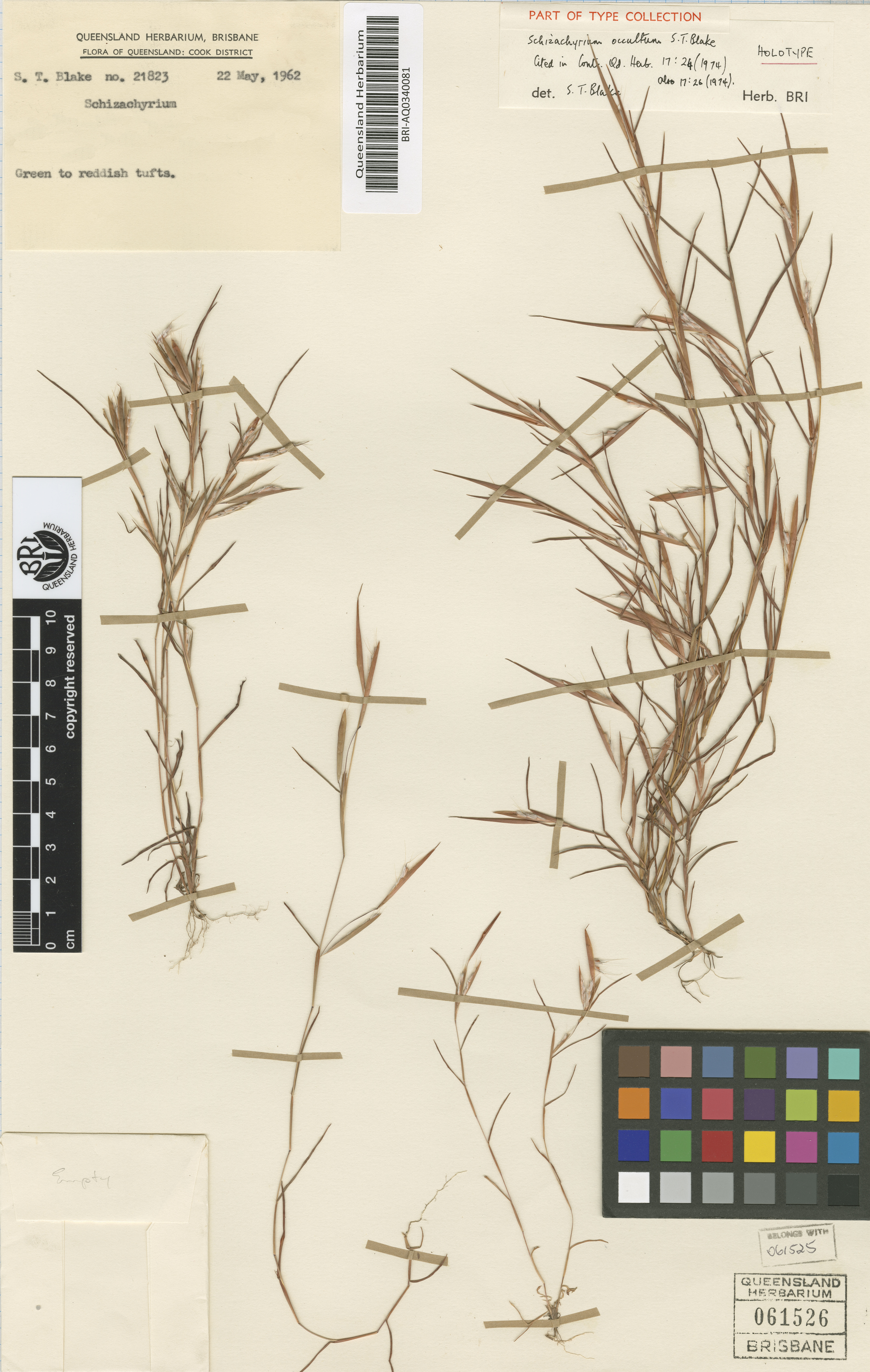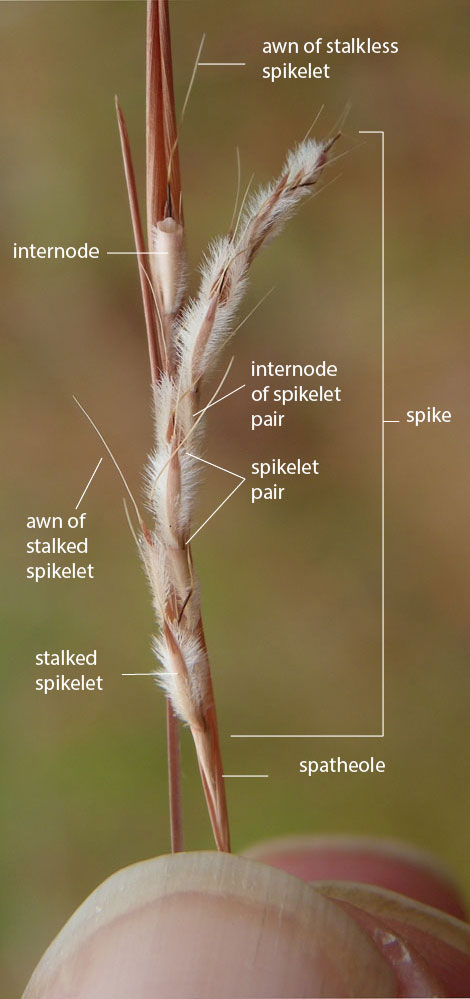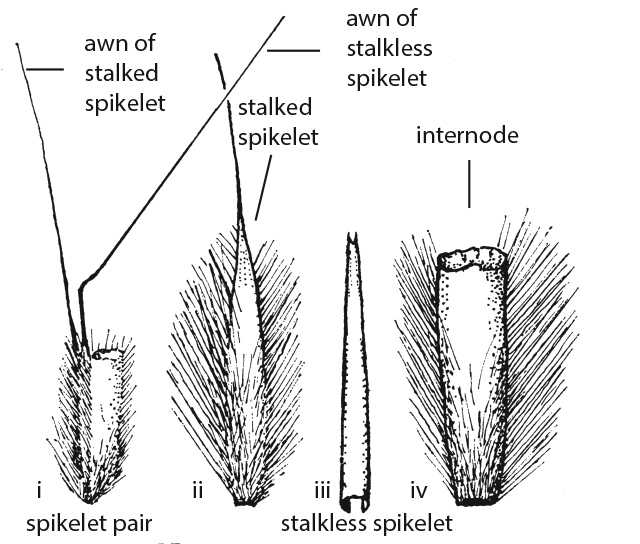Schizachyrium occultum
(Hosok.) S.T.Blake
This species is a very slender and delicate annual, tufted or single stemmed, and found on sandy soils usually associated with other species of Schizachyrium. Usually erect or becoming erect, up to 45 cm tall, with leaves arising from the base and along the stems (Fig. 1). The stems give rise to one or a few separate flowering spikes each enclosed or partially enclosed in a leaf-like sheath (or spatheole) (Fig. 2). The basic flowering units or spikelets are arranged in compact pairs, each pair arranged one after the other in what appears as a solid flowering spike (Fig. 2). The flowering spike becomes fragile with age and breaks apart between the pairs of spikelets (Fig. 3 & 4i). Each spikelet pair consists of a stalkless spikelet, a stalked spikelet and an internode (a segment of the flowering stem) (Fig. 4). The spikelet pairs are usually obscured by long white hairs on the internode and stalked spikelet. Dissection and magnification of the spikelet pair is usually required to observe the characters useful for identification. The stalkless (sessile) spikelet in this species is obscured between the stalked spikelet and the internode (Fig. 3). The lower glume of the stalkless spikelet, is flattened from side to side (so that the spikelet is narrower than deep), has no flaps or wings along the lower glume edges and tapers into a fine tip (Fig. 4iii). The stalkeless spikelet contains 1 fertile floret (a modified grass flower) with a distinct awn or bristle which is bent a 1/3 to half away along of its length (Fig. 3 & 4i). The stalked spikelet consists of a single glume only, tapered into a bristle or awn (Fig. 3 & 4ii). Although it is much smaller than the glume on the stalkless spikelet it appears larger as the stalk and glume look like one structure. In this species the internode is very stout, and the stalked spikelet very conspicuous and may be misinterpreted as the stalkless spikelet (Fig. 3ii & 4ii). Be aware that the terminal spikelet cluster occuring at the tip of each flowering spike will often have two stalked spikelets which does not reflect the typical spikelet arrangement of the other spikelet pairs described above.
Botanical Description (ATH)
Annual. Culms erect, stature slender to delicate, 10-45 cm tall. Leaf-blades 1.5-3.5 cm long, 0.6-2 mm wide, conduplicate or convolute, surface scaberulous except above middle. Inflorescence a rame (an unbranched inflorescence in which the main axis produces a series of paired spikelets, one sessile and one pedicellate, the oldest at the base and the youngest at the top), 1.2-2.7 cm long, 5-10 jointed (Fig. 2). Rhachis fragile at the nodes (Fig. 2 & 3). Spikelets partially enclosed in spatheole at maturity (Fig. 2). Sessile spikelets 3.7-5 mm long, very, laterally compressed, lower glume not winged (Fig. 4iii), lemma awn 9-13 mm long (Fig. 2). Pedicelled or companion spikelet on stalk longer than sessile spikelet, glume 0.9-1.2mm long, awn 5-8 mm long. The rhachis internode, is very stout and pubescent on the back (Fig. 4iv).
Diagnostic Features (ATH)
The slender flowering spikes emerging from a leaf like sheath are characteristic of most Schizachyrium species seen in northern Australia. Schizachyrium occultum is distinguished by the narrow insignificant stalkless spikelet tightly wedged between the much more conspicuous stalked spikelet and stout internode (Fig. 3). The stalked spikelet is often initially confused with the stalkless spikelet in this species because it is so much more prominent (Fig. 3ii). Although these characters are readily recognised when inspected, this species is not well collected, perhaps because it is associated with other species and maybe overlooked. Both S. occultum and S. dolosum have robust stout internodes and prominent stalked spikelets, however, S. dolosum can be distinguished by the stalkless spikelet which is easily visible with a hand lens (Fig. 5a & b).
Identification keys to other species in the area can be found at Simon & Alfonso (2011).
Natural Values (CYNRM, ATH, others)
The species in this genus are collectively referred to as firerass in Crowley et al (2004) and are considered a critical food source for the Golden Shouldered Parrot. Schizachyrium species produce large amounts of seed which fall to the ground and persist through the dry season. They provide an important food source for many seed-eating specialists before the seeds start to germinate in the early wet season. Although recorded as being grazed by stock they are not considered a valuable fodder species, probably because they offer little in the amount of bulk for grazing stock (Simon 1992, Rolfe 1997, Milson 2000, Lazarides 2002).
Habitat
Found in sandy soils of northern Qld and Northern Territory (NT), usually associated with other Schizachyrium species. (Simon & Alfonso 2011). This species is only known from one collection in the region (Fig ).






Resources
AVH (2018) Australia’s Virtual Herbarium, Council of Heads of Australasian Herbaria, <http://avh.chah.org.au>, accessed 1 Mar 2018.
Blake, S.T. (1974), Revision of the genera Cymbopogon and Schizachyrium (Gramineae) in Australia. Contributions from the Queensland Herbarium 17: 8-14
Crowley, G.M., Garnett, S.T. and Shephard, S. (2004). Management guidelines for golden-shouldered parrot conservation. Queensland Parks and Wildlife Service, Brisbane.
Garnett ST and Crowley GM. 2002. Recovery Plan for the golden-shouldered parrot Psephotus chrysopterygius 2003-2007. Report to Environment Australia, Canberra. Queensland Parks and Wildlife Service, Brisbane.
Hooker, Nanette B. (2016) Grasses of Townsville. James Cook University, Townsville, QLD, Australia.
Lazarides, M. (2002). Economic attributes of Australian grasses. Flora of Australia 43: 213-245.
Milson, J. (2000). Pasture plants of north-west Queensland. Information Series Q100015. Queensland Department of Primary Industries.
Rolfe, J., Golding, T. and Cowan, D. (1997). Is your pasture past it? The glove box guide to native pasture identification in north Queensland. Information Series Q197083. Queensland Department of Primary Industries.
Simon, B.K. in Wheeler, J.R. (ed.) (1992), Schizachyrium. Flora of the Kimberley Region: 1215
Simon, B.K. & Alfonso, Y. (2011) AusGrass2, http://ausgrass2.myspecies.info/accessed on [8 February 2018].

